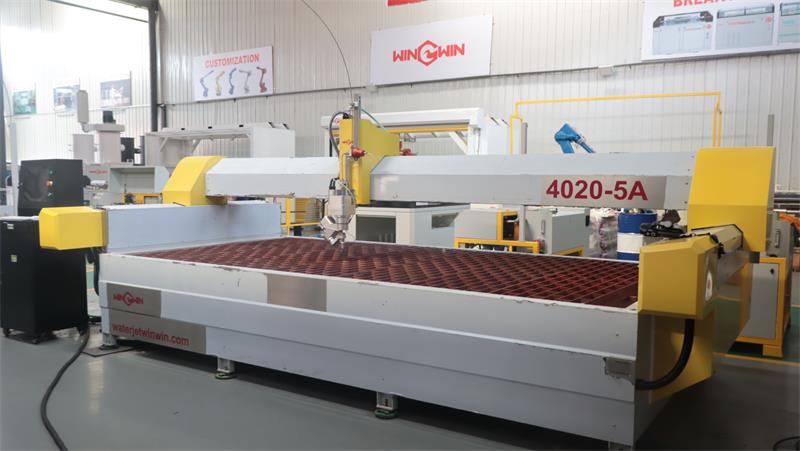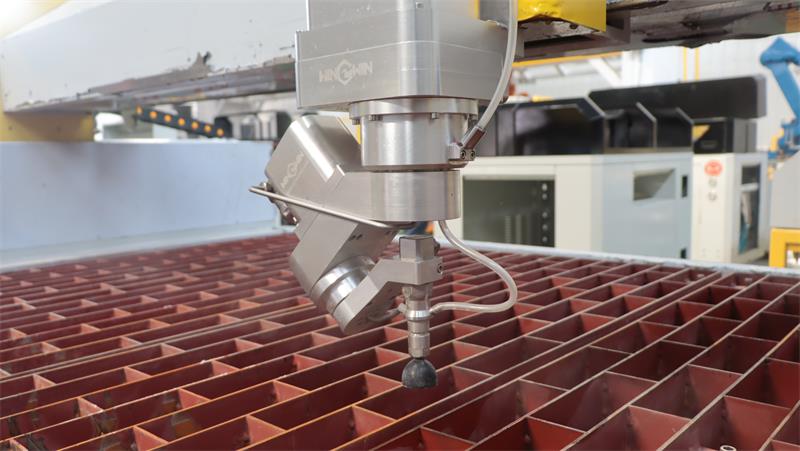Waterjet cutting is an ideal method for cutting glass due to its high precision, clean cuts, and ability to cut complex shapes. Here are some key considerations when using waterjet cutting for glass:
Water pressure: When cutting glass, it's important to use the right water pressure to avoid cracking or chipping the glass. A lower water pressure is generally recommended for cutting glass, as it reduces the risk of damage to the glass.
Abrasive material: When cutting thicker glass or glass with a textured surface, abrasive material may be necessary to achieve a clean cut. However, for thinner glass or smooth glass surfaces, pure waterjet cutting may be sufficient.
Cutting speed: The cutting speed for glass will depend on the thickness of the glass and the desired level of precision. For thicker glass, a slower cutting speed may be necessary to achieve a clean cut.
Cutting path: The cutting path for glass should be carefully planned to avoid unnecessary stress or pressure on the glass. The cutting path should follow the natural shape of the glass and avoid sharp angles or sudden changes in direction.
Cutting table: A specialized cutting table may be necessary for cutting glass with a waterjet. The cutting table should be designed to support the glass and prevent any movement or vibration during the cutting process.
Edge finishing: After cutting, the edges of the glass may require finishing to remove any rough edges or burrs. This can be done using various techniques, such as sanding orpolishing.
Safety: When handling glass, it's important to take proper safety precautions to avoid injury. Wear gloves and protective eyewear when handling glass, and be aware of the potential for sharp edges or shards.
waterjet cutting is an excellent method for cutting glass due to its precision and ability to cut complex shapes. However, it's important to use the right water pressure, cutting speed, and cutting path to avoid damaging the glass. With the right equipment and techniques, waterjet cutting can produce high-quality, clean cuts in glass for a variety of applications, such as architectural glass, decorative glass, and glass art.

Cutting glass with a water jet requires skill and precision, and there are several common mistakes that people can make when attempting to cut glass with this method. Here are some of the most common mistakes people make when cutting glass with a water jet:
Using the Wrong Nozzle and Abrasive
Using the wrong nozzle and abrasive can cause damage to the glass and result in an inaccurate cut. The nozzle size and abrasive material should be selected based on the thickness and type of glass being cut. Using the wrong nozzle or abrasive can cause chipping, cracking, or other damage to the glass.
Inadequate Cutting Pressure
Inadequate cutting pressure can result in an inaccurate cut or cause the glass to crack or chip. The cutting pressure should be set to an appropriate level based on the thickness and type of glass being cut. If the cutting pressure is too low, the glass may not be cut cleanly or accurately.
Improper Glass Securing
Improperly securing the glass can cause it to shift or vibrate during the cutting process, resulting in an inaccurate cut or damage to the glass. The glass should be held firmly in place using a vacuum table or other clamping system to prevent movement during cutting.
Incorrect Cutting Speed
Cutting speed that is too slow or too fast can result in an inaccurate cut or cause the glass to crack or chip. The cutting speed should be adjusted based on the thickness and type of glass being cut. For example, thicker glassmay require a slower cutting speed, while thinner glass may require a faster cutting speed.
Overloading the Cutting Table
Overloading the cutting table with too much glass can cause the glass to shift or vibrate, resulting in an inaccurate cut or damage to the glass. The cutting table should be loaded with only the amount of glass that can be securely held in place during cutting.
Neglecting to Clean the Cut Edge
Neglecting to clean the cut edge of the glass after cutting can result in residual abrasive material or debris remaining on the surface, which can cause damage or scratches. The cut edge should be cleaned thoroughly to remove any residual material or debris using a specialized cleaning tool or a clean cloth.
Not Using a Protective Coating
Not using a protective coating on the surface of the glass before cutting can result in scratches or other damage to the glass. A protective coating should be applied evenly before cutting to protect the surface of the glass.

Improper Maintenance of Equipment
Improper maintenance of the water jet cutting machine, such as failing to change the abrasive material or clean the cutting nozzle regularly, can cause damage to the glass or result in inaccurate cuts. Regular maintenance of the equipment is essential to ensure reliable and accurate cutting.
In conclusion, cutting glass with a water jet requires careful attention to detail and proper technique to ensure accurate and clean cuts. Some of the most common mistakes made when cutting glass with a water jet include using the wrong nozzle and abrasive,inadequate cutting pressure, improper glass securing, incorrect cutting speed, overloading the cutting table, neglecting to clean the cut edge, not using a protective coating, and improper maintenance of equipment. It is important to consult with a water jet cutting expert and follow recommended guidelines and techniques to ensure a safe and effective cutting process. By avoiding these common mistakes, water jet cutting can be an efficient and precise method for cutting glass.
Waterjet cutting is capable of cutting glass of varying thicknesses, depending on the specific machine and cutting parameters. However, the thickness of the glass that can be cut with a waterjet will depend on several factors, including the water pressure, cutting speed, and the type of abrasive material used (if any). Here are some general guidelines for the thickness of glass that can be cut with a waterjet:
Pure waterjet cutting: A pure waterjet can typically cut glass up to a thickness of around 1 inch (25 mm). However, the cutting speed will be slower compared to abrasive waterjet cutting, especially for thicker glass.
Abrasive waterjet cutting: Abrasive waterjet cutting can cut thicker glass than pure waterjet cutting, typically up to 6 inches (150 mm) or more, depending on the specific machine and cutting parameters. The use of abrasive material allows for faster cutting speeds and the ability to cut through harder and thicker materials.
It's important to note that the thickness of the glass that can be cut with a waterjet will also depend on the desired level of precision and the complexity of the cutting shape. Thicker glass may require a slower cutting speed to ensure a clean, precise cut, and complex shapes may require additional cutting passes or adjustments to the cutting parameters. Additionally, the thickness of the glass will affect the cutting process, as thicker glass will require more water pressure and may be more prone to cracking or chipping. The specific cutting capabilities ofa waterjet machine will depend on its specifications and the cutting parameters used. Therefore, it's important to consult with the manufacturer of the specific machine and experiment with different cutting parameters to determine the maximum thickness of glass that can be cut with a waterjet.
| MATERIAL | THICKNESS | CUTSPEED |
| [in] | [in/min] | |
| METAL | ||
| Aluminum | 1/16" | 2.8 ipm |
| Aluminum | 1/8" | 1.8 ipm |
| Aluminum | 1/4" | 1.0 ipm |
| Mild Steel | 0.051" | 1.2 ipm |
| Mild Steel | 3/16" (max) | 0.4 ipm |
| Stainless Steel | 0.058" | 1.0 ipm |
| Stainless Steel | 1/8" (max) | 0.7 ipm |
| Titanium | 1/16" | 1.4 ipm |
| Titanium | 3/16" (max) | 0.6 ipm |
| Copper | 1/16" | 1.2 ipm |
| Copper | 3/16" (max) | 0.6 ipm |
| Nickel Silver | 0.037" | 1.8 ipm |
| CERAMIC &STONE | ||
| Glass (soda-lime) | 1/8" | 11.8 ipm |
| Glass (plate) | 3/8" | 1.6 ipm |
| Granite | 3/8" (max) | 0.8 ipm |
| Marble | 3/8" | 1.6 ipm |
| Ceramic Tile | 3/8" | 2.0 ipm |
| OTHER | ||
| Polycarbonate | 1/4" | 1.8 ipm |
| Polycarbonate | 1/2" (max) | 0.6 ipm |
| Carbon Fiber | 1/8" | 8.9 ipm |
| Garolite (g10) | 1/16" | 15.7 ipm |
 wwaterjet
wwaterjet